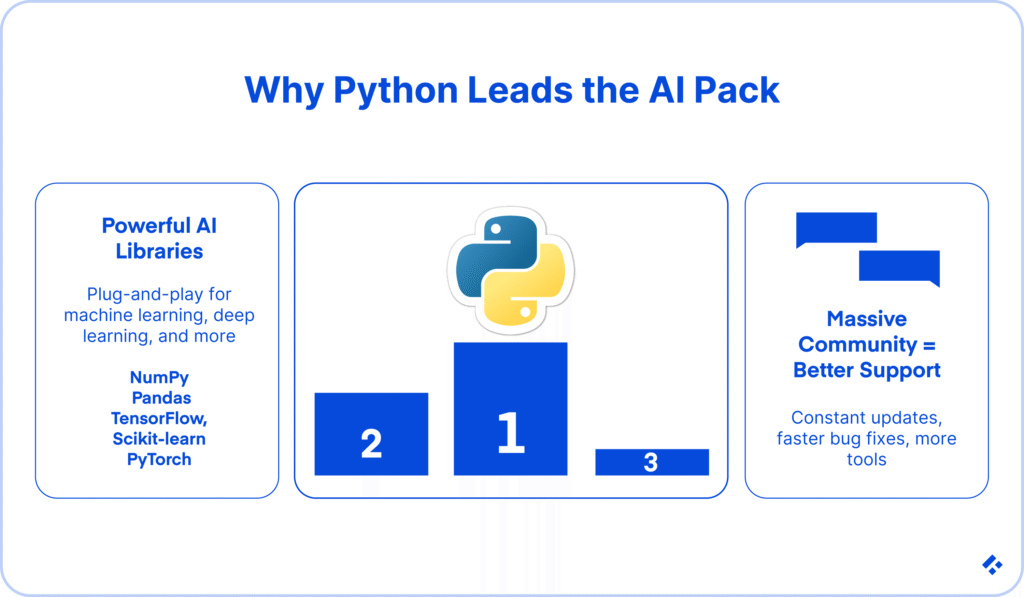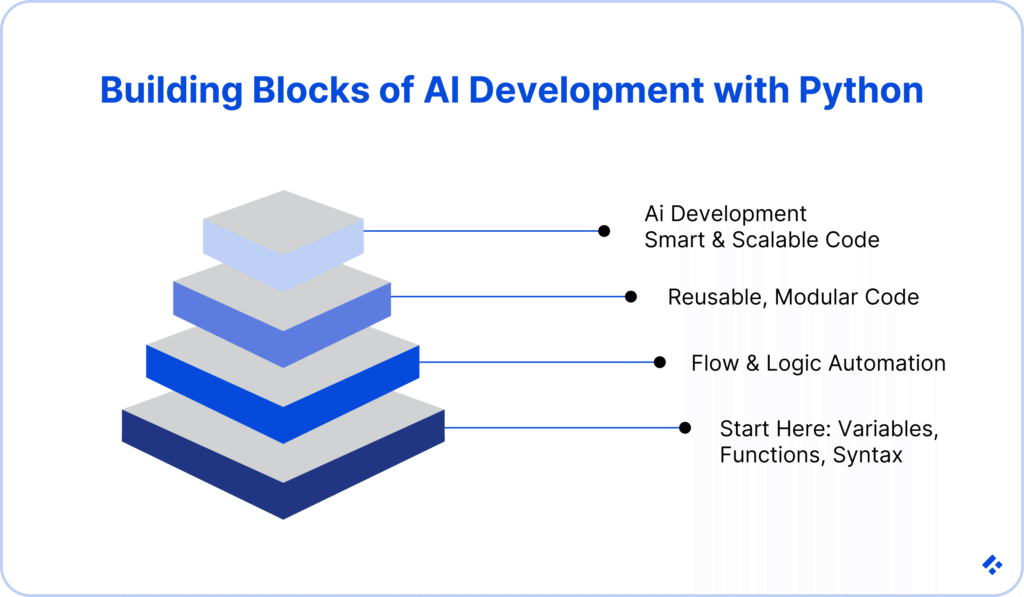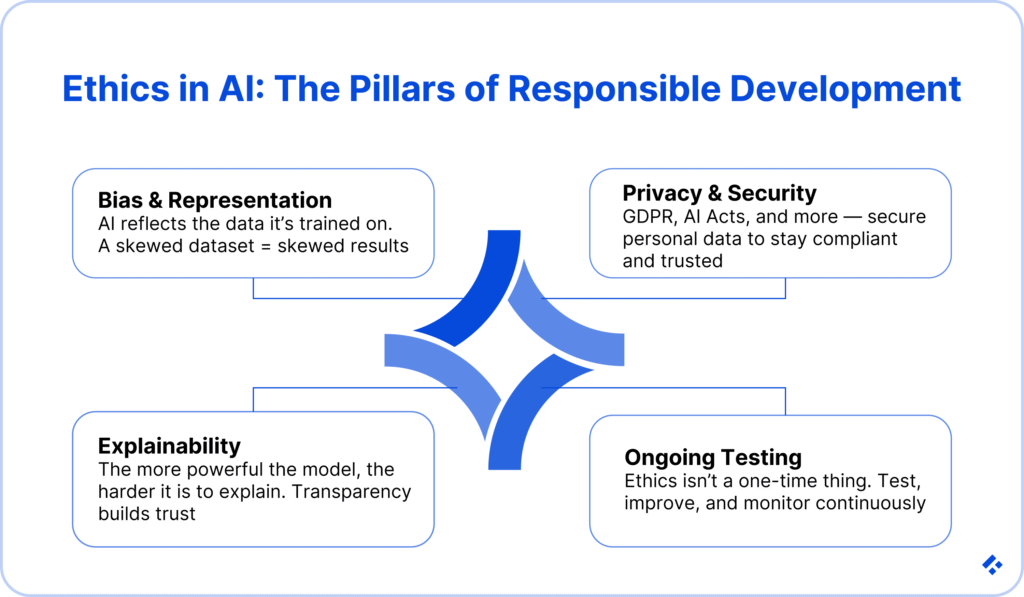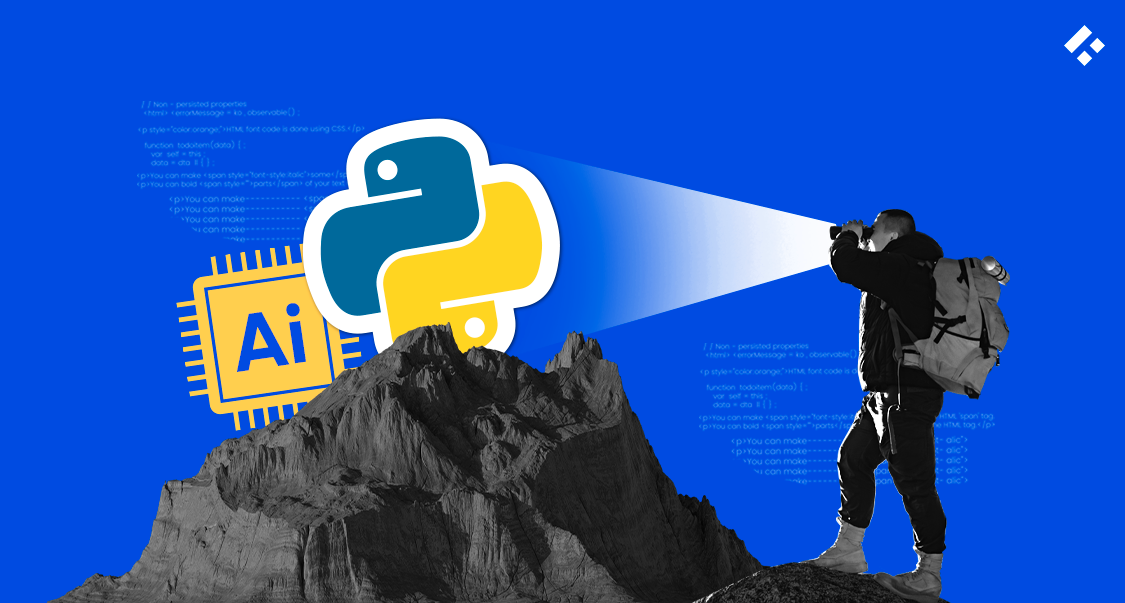AI is no longer the stuff of the future. Although the concepts of AI and machine learning are nothing new, they have only become widely used publicly since the rise of large language models like ChatGPT. Now, it’s like AI is everywhere you look, from recommendation engines and virtual assistants to autonomous vehicles and fraud detection.
Python is one of the major programming languages that powers it all! But the jump between learning the basics of how to use Python and mastering AI in Python development can be quite daunting. Let’s walk through everything that you need to know.
If you need to get an expert on your team quickly, you are in the right place. At Trio, we specialize in connecting you with the right developers in a matter of days, sometimes hours. Our AI and automation experts have experience writing Python code quickly and efficiently, so you can have a high-quality product to work with as soon as possible.
Why Choose Python for AI?
Why is Python so popular for AI? It’s no coincidence. Python has very simple syntax and structure. This simplicity makes it easy to grasp the Python basics, making it one of the easiest languages for new developers to learn. It also has a massive community and a large ecosystem of libraries and frameworks, suitable for everything from AI and machine learning to data science and deep learning.
Some popular examples include tools like NumPy, Pandas, Scikit-learn, TensorFlow, and even PyTorch! Python can also integrate with libraries written in C and C++ and cloud platforms, meaning it’s incredibly scalable!
And, with a massive community, there are not only a bunch of new tools appearing all the time to address new issues, but there’s also a lot of support if you do run into any issues.
But isn’t this what all other languages also offer? What about the most powerful languages like R, Java, and C++?
While all of these have their own strengths, Python still comes out on top as one of the most versatile. R is very inflexible, and Java and C++ are both very difficult to learn and use. Python is well-rounded and balanced. This is one of the many reasons we recommend that new developers learn Python when they are just starting out.

Key Concepts in Artificial Intelligence
Beyond programming with Python, there are some key concepts you will need to know in order to build AI applications.
Machine Learning vs Deep Learning
AI development involves both machine learning algorithms and deep learning. So, what’s the difference between the two? Well, all deep learning is machine learning, but not all machine learning is deep learning.
Think of machine learning as the blanket term between the two. It is a subset of AI learning techniques, where algorithms learning using data. Deep learning is a lot more complex, using neural networks to process this data in multiple layers. Deep learning frameworks mimic the way our brains work, so the product is often a lot better.
While most machine learning models deal with straightforward problems, deep learning is required for image or speech recognition.
Neural Networks Explained Simply
We’ve already mentioned that neural networks are a bit like the human brain. Usually, they involve some input, hidden, and output layers.
In other words, each neuron receives an input, performs a calculation, and passes it forward to the next one. Think of natural language processing platforms like ChatGPT. You can provide it with a question, it will analyze your text to figure out what you are saying, analyze the data it has been trained with to formulate an answer, and then figure out how to return that information to you.
You could also provide it with different data types: text, numbers, images, sounds, and much more, and these neural networks will take care of it.
Over time, these networks pick up on patterns, usually through training, such as reinforcement learning.
Feature Engineering and Data Preparation
The data structures you provide AI solutions aren’t always the best. Feature engineering is where data manipulation occurs in the form of transformation and selection. In the end, this means the most meaningful features are emphasized and your AI systems perform a lot better.
This seems complicated, but to understand the kind of changes made, you can think of what would make it easier for you to deal with the data yourself, if you were taking a hands-on approach. You might have to craft new features from old ones, or focus on normalization to scale values.
Categories aren’t always usable in the way you might be able to infer, so techniques like one-hot encoding might be used.
This is incredibly important. Bad data means inaccurate results. If you are training your models, you need to put the work in yourself, prepping the data you plan to use. But, in advanced AI models, like those that use deep learning, the AI itself could do this once trained.
Training vs Inference
We keep mentioning training. What does this mean in the world of artificial intelligence?
Training is the learning phase of your AI technology. Once you have built it with the Python programming language, you then need to selectively feed it information so it can crunch data, identify patterns, and adjust its internal parameters.
This is by far the most time-intensive part of the AI journey. It also takes a lot of computational power, but it is important to get it right, and train your tool as thoroughly as you possibly can to get the best result at the end of the day.
Inference happens after the initial training. Your AI has large datasets to refer to, so when you give it new data, the model can make predictions or decisions based on its frame of reference.
The difference between training and inference is like the difference between memorizing information and applying it.
Required Skills and Prerequisites
If you want to build an AI model of your own, where do you even start? Here’s everything you’ll need to know in order to start AI programming with Python.
Basic Python Programming
Of course, you’ll need a solid foundation in Python programming. This includes all of the basics, like how to use the different variables, data types, functions, loops, classes, and putting them all together in a functional Python syntax. You also need to keep up to date with any changes in new Python versions. You can find these changes in the official Python documentation.
This will help you write and run scripts without issues, and debug your code.
Outside of the basics, you will also need a fair knowledge of some of the most commonly used libraries that Python supports. These include libraries like math, random, and itertools.
You can definitely learn all of this on your own, but we would recommend that you go through a course or structured program with supervised learning of some sort to make sure that you don’t miss anything. Codecademy, W3Schools, and Real Python are all great options that have detailed Python tutorials.
Math Essentials
Basic math is generally required for most basic programming systems, and especially for the kind of programming used in AI.
Linear algebra is a must for machine learning and data analysis. You’ll need it for vectors, matrices, matrix multiplication, dot products, and eigenvalues. These are all essential when building the basics that you need to build on for neural networks or tensor manipulations using machine learning libraries.
When you get into complex deep learning, Calculus can help you understand how your models are learning, and even how they make decisions. Gradients, derivatives, and partial derivatives are therefore critical in helping you identify where potential issues might be coming from and, more importantly, how to fix them.
Then, of course, a good idea of probability and statistics is going to be a great asset as you move into AI tasks like forecasting. Realizing when your AI has a bias of some sort is also a lot easier if you have at least basic knowledge of probability, statistical testing, and concepts like expectation and variance.
While none of this is strictly required for software development, it can be very helpful and end up saving you a lot of time you would otherwise have spent looking for answers in the Python community.
Foundational Programming Concepts
Outside of the very basics of Python itself, you’ll also need to understand how things like loops, modularized code, and control flow statements work. If you’ve worked on any hands-on projects – regardless of the programming language – you should have a fairly good idea of these points already, as they are pretty consistent across languages.
Knowing what object-oriented programming (OOP) is and how to do it is also quite important for AI development with Python, as it lets you code in a very organized, methodical manner, so that you can end up reusing large sections of code later.
This isn’t such a big deal if you are experimenting with something small, but trying to incorporate it from the start is ideal so that you don’t run into any issues if you decide to scale later. That kind of foresight is something our developers take pride in here at Trio.
For example, instead of carelessly coding a small fintech MVP to just ‘get the job done,’ our developers will know that there is a chance you’ll want to grow your app in the future, adding exciting AI features as the markets shift, and will code in such a way that future changes are simple and quick.

Tools and Libraries You’ll Need
Now we know the kind of basic AI skills you’ll need, let’s look at some more specific tools you might be able to take advantage of for AI and programming in general.
Development Environment
We would recommend that you check the version of Python you have installed before you start anything else. It’s always a good idea to have the latest version, or to try and be no more than one version behind if you think you’ll need certain features that are no longer available in the latest version.
You’ll also need a package manager. There are a couple of different options to choose from. Some Python developers swear by Anaconda, while others love pip. The latter is Python’s preferred installer and is even included by default with the latest Python binary installers, so we would recommend that if you don’t have a blaring reason why you can’t.
If you decide to go with pip, then the default choice for managing application dependencies will be Pipenv, but you could still make use of other options like Virtualenv if you have experience with it. Do your research before you start, though, so you don’t make your life more difficult later.
Finally, you’ll need an IDE (Integrated Development Environment). Visual Studio Code (VS Code), PyCharm, Spyder, Atom, Jupyter Notebooks, and many other options are at your disposal. Some of them are web-based, while many will require a desktop app.
Popular Python Libraries for AI
Python’s massive ecosystem is one of the many reasons why it is so loved, but if you are new to Python, the variety can also feel overwhelming. To make things a bit easier for you, let’s look at the most popular libraries for AI specifically, so you have a good starting point to work with.
For data handling and visualization, you could find great success using only NumPy, Pandas, and Matplotlib/Seaborn. NumPy lets you use fast array operations, while Pandas provides flexible data structures. Matplotlib and Seaborn are both tools for data visualization. The latter is slightly easier and cleaner, but the former gives you more control over plots.
For machine learning tasks, our Python developers love Scikit-learn. There are many different options, but this is generally a good starting point as it’s very user-friendly and has a bunch of pre-made algorithms ready for you to use, while still supporting model evaluation tools and pipeline management that you will need to integrate into your workflow later.
If you want to dive into the complicated world of deep learning, try TensorFlow or PyTorch. The latter has definitely become more popular in recent years, thanks to how intuitive it is. TensorFlow is barely used anymore, but it could still be worthwhile to experiment with because of its great deployment support.
NLTK and spaCy are good options for natural language processing. NLTK is best for basic tasks, while spaCy is better for anything that requires speed, like a chatbot. But either would be a great choice if your app isn’t too complicated and you are still on your learning journey.
How to Create an AI with Python (8 Steps)
Now that you’ve got an idea of everything you need, let’s go into the specifics. How do you build an AI with Python? We can break the process down into several steps.
Step 1: Define the Problem
The first step to creating any piece of software is to decide what you want it to do. What problem will you be solving? Some common examples for AI include spam filters, price predictors, or even simple tools that make inferences and group data sets.
Generally, the problems you will solve with very simple AI can be grouped into three options: classification (spam or not spam), regression (price prediction), and clustering (grouping).
You can get more complicated, of course, but we recommend that you first approach these categories as you learn how to build Python programs, before attempting something like your own generative AI model.
Step 2: Collect and Preprocess Data
Once you’ve figured out what issue you are going to address, you should have a fairly good idea of the kind of data you will need to train your AI. For example, if you are trying to create something that identifies whether an email is spam or not, you would need a lot of information on the kind of emails that are considered spam, and those that are not.
Now, you need to collect that data and clean it up for usability. This can be a very time-consuming process that involves scraping websites, downloading datasets, using APIs, and then manually handling any missing values or converting them into a single, usable format through encoding and normalization, etc.
The more data you have, and the more accurate it is, the better your product is going to perform.
Step 3: Choose the Right AI Model
There are different types of AI models for different types of tasks. A decision tree is the most basic example, while complex Support Vector Machines (SVMs) are best for dealing with text and images.
In cases where you are trying to get an AI to perform more like human intelligence, a neural network is really the only option. We’ve already discussed these above.
Your choice for an AI model will depend on your requirements as well as your programming experience. If you find yourself in need of something complex, getting an expert on your team is probably your best bet, especially in fields where mistakes can cost you in both time, money, and your reputation, like FinTech!
Step 4: Train the Model
Once your Python scripts are set up, you need to start feeding them with the information you have prepared. We recommend that you split this information into two different sets: training and validation. This will help you prevent something known as overfitting, when your model is so focused that it can’t make correct predictions based on new data. Batch size is incredibly important.
As you train your model using methods like Model.fit(), its parameters should be updated. Most people will train over several epochs, or passes through the dataset, to see how it responds and make sure that the model is accurate, but not unable to stray from what it knows or extrapolate.
Step 5: Evaluate the Model
Finally, you will need to evaluate your model and figure out if it’s doing what you need it to, or if you need to make a couple of tweaks. The best way that we have found this is to look at certain figures that serve as performance indicators. These include accuracy, precision, recall, confusion matrix, and F1-score.
Precision and recall will help you understand how the model handles different types of errors, while a confusion matrix will be a great asset in identifying the regularity of false positives and negatives. An F1-score is one of the best ways to evaluate your models, especially when your data is unbalanced.
These should also give you a baseline that you can refer back to if you decide to make changes in the future.
Step 6: Test the Model
Once you are happy with your evaluation results, you can move on to testing your model with data that it has never seen before to get an idea of how it will function in real-world situations.
Cross-validation can be a great tool here. This is where you train and test your models on multiple different splits of your data (think of something like A/B testing in marketing), and make sure that it is still consistent.
Rigorous testing is especially important for critical fields like healthcare and economics, but you’ll want to be able to showcase your process even if you are not in one of these fields, so that you have something to show to future investors if your model ends up growing. It is even valuable to have this documentation if you just want to include the model in your portfolio.
Step 7: Deploy the Model
Coding and training are, unfortunately, not the entire story. The deployment process involves making use of APIs and using frameworks like Flask or FastAPI so that other applications or users are able to use your model.
You might even want to use something like Streamlit to create a web interface and provide a more interactive experience. This is a great way to provide users with demos and internal tools, which can help you build a reputation for attention to detail and a trustworthy brand in sectors where this kind of thing is valued.
Step 8: Monitor and Improve the Model
Once you have successfully deployed your model, make sure that you keep monitoring it. This is the time when your model will encounter data that it was not trained on. You may have to make adjustments and implement retraining in some cases.
Users might also have some valuable feedback, which you can use alongside things like performance logs to ensure that you are producing an accurate and user-friendly product that works as people expect it to.
Real-World Examples of AI Projects in Python
Some obvious examples of AI projects may jump to mind immediately, while others may take you by surprise. It’s a good idea to know what’s already out there, either way, so that you understand where there might be a market need, or where you might fit in.
- Chatbots: Found a lot on e-commerce sites and answer common questions or help as far as they can before getting a human involved.
- Image Recognition App: Google Lens is probably the most popular example and can identify a variety of objects utilizing a photo.
- Spam Email Classifier: Already found in most email service providers, like Gmail, they detect spam articles and isolate them in some way.
- Recommendation Engine: Also common in e-commerce sites, as well as content-based sites, and uses user behavior to predict what they’ll like. Think of the recommended products on Amazon, or recommended movies on Netflix.
- Sentiment Analysis Tool: Quite complex, these try to figure out the emotional tone, or overall perception people might have of a brand or item. They usually use information from product reviews or social media sites.
Tips, Best Practices, and Common Mistakes
There are some mistakes that are fairly common. Although you’ll learn from experience, knowing about them beforehand can make your AI development process a lot smoother and save you a couple of headaches.
Tips for Beginners
Don’t try to save the whole world using AI for your first project. While there is a lot of potential in this field, starting small is key to ensuring you actually understand what you are doing and can build something of high quality later on.
Knowing what your model is doing and how it works will help you find mistakes faster, and will allow you to scale more easily in the future.
Similarly, while it can be difficult to find real data to train your AI in, shortcuts produce mediocre results. You need to find real data to train your AI, and sometimes a simple project can help you get the hang of not only finding data, but also making it usable.
Common Mistakes to Avoid
Too much data seems like a ridiculous problem to have, but it is definitely a thing. There’s a really fine line between training your model thoroughly and overfitting. It’s more of an art than a science, which is why you need to start small, and why getting an expert on your team can be very helpful.
Similarly, not cleaning your data up can lead to issues down the line, although this is relatively simple when you get the hang of it. It is incredibly time-consuming, though, and we’ve seen many people skip this step only to regret it later.
Another common mistake we have seen is not tuning your model’s hyperparameters. This means you aren’t targeting your specific data or problem. Most libraries will let you adjust things like the learning rate or layer numbers, so make sure that you tweak these figures to produce the most optimal results.
And lastly, don’t underestimate the importance of evaluation. You want to fix any issues before you let people use your program. Be proactive instead of reactive.
Ethical Considerations in AI
With how popular AI has become in recent years, a lot of new products have appeared on the market. Unfortunately, as the world has used them more and more, we’ve realized that there are certain ethical considerations that need to be made, or you’ll quickly start to run into issues.
AI is not all-knowing or perfect. While opinions about the possibility of the singularity are divided, one thing is certain: we are nowhere near it yet. Instead, AI is a product of the data it is trained on, nothing more and nothing less. This means it can be biased.
A biased AI isn’t really a big issue if you are going for something simple or just experimenting, but when it comes to big projects, like using AI in fintech or healthcare, or even to run simulations in scenarios like machinery maintenance prediction, biases can be highly detrimental.
The only way to ensure your AI isn’t biased is to make sure your dataset is diverse and then keep testing it as you continue to improve it or make additions.
This gets very difficult in larger models.
While large models are the most useful, they are difficult to interpret or explain. Investors and customers might want to know how the AI came to its decision, especially as the world starts to value transparency more, which may require you to invest in additional tools.
Last but definitely not least, privacy and data security considerations. Laws like the GDPR are going to affect you, even if you use the most basic data. New laws specifically targeting AI are also becoming more common, like the EU AI Act.

All of these ethical considerations can be overwhelming, especially if you are only one person or a small startup trying to get your product out on the market. Luckily, it is easier than ever to find the right expert for you.
At Trio, we have a host of AI and automation experts. These developers are not only experienced in Python code, but have worked on real projects in a couple of different industries and understand the nuances of building an AI with Python for fintech, healthcare, or a variety of other fields.
If you are interested in getting a developer on board through staff augmentation or outsourcing your project to a dedicated team, reach out to schedule a free consultation and find your partner in success today!






